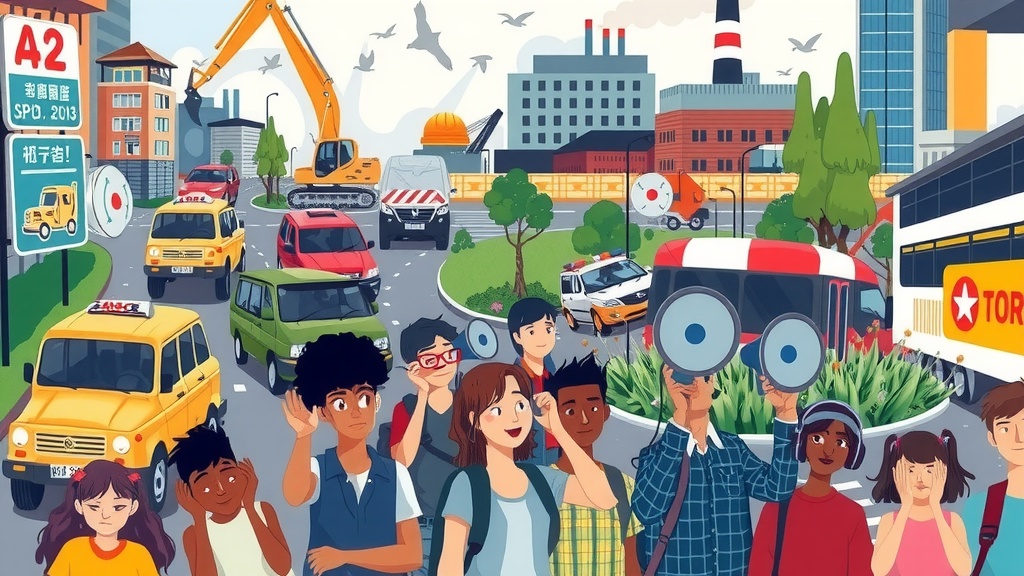Imagine trying to enjoy a peaceful evening, only to be bombarded by the relentless honking of horns, the blare of loudspeakers, and the rumble of construction. That, my friends, is sound pollution in a nutshell. In Bangladesh, especially in bustling cities like Dhaka, sound pollution is more than just an annoyance; it's a serious environmental and health hazard. So, let's dive into understanding what sound pollution is, its causes, effects, and what we can do about it.
What is Sound Pollution?
Sound pollution, also known as noise pollution, is unwanted or excessive sound that can have adverse effects on human health, wildlife, and environmental quality. Think of it like this: your favorite song played at a reasonable volume is music to your ears, but the same song blasted at full volume in the middle of the night? That's sound pollution!
Understanding the Decibel Scale
Sound is measured in decibels (dB). A whisper is around 30 dB, normal conversation is about 60 dB, and a rock concert can reach 120 dB. Prolonged exposure to sounds above 85 dB can cause hearing damage. In Bangladesh, permissible sound levels vary by area, but are often exceeded, especially in urban areas.
Table 1: Common Sound Levels and Their Effects
| Sound Source | Decibel Level (dB) | Potential Effects |
|---|---|---|
| Whisper | 30 | Generally harmless |
| Normal Conversation | 60 | Comfortable, no risk of hearing damage |
| City Traffic | 85 | Risk of hearing damage with prolonged exposure |
| Rock Concert | 120 | Immediate risk of hearing damage |
| Jet Engine at Takeoff | 140 | Painful, immediate and permanent hearing damage risk |
Causes of Sound Pollution in Bangladesh
Bangladesh, with its dense population and rapid urbanization, faces significant challenges in managing sound pollution. Several factors contribute to this problem.
Traffic Noise: The Unrelenting Hum
The sheer volume of vehicles on the roads, combined with frequent honking, creates a constant barrage of noise. In Dhaka, traffic jams are legendary, and so is the cacophony of horns that accompany them.
- Vehicular Density: More cars, buses, and motorcycles mean more noise.
- Honking Culture: Honking is often used as a way to navigate through traffic, even when it's unnecessary.
- Poor Vehicle Maintenance: Old and poorly maintained vehicles tend to be louder.
Construction and Industrial Activities: The Rhythmic Clatter
Construction sites and industrial areas are major sources of noise pollution. The sounds of machinery, hammering, and heavy equipment can be deafening.
- Construction Sites: Jackhammers, bulldozers, and cranes contribute to high noise levels.
- Factories and Workshops: Industrial machinery and processes generate significant noise.
- Lack of Noise Control Measures: Many construction sites and factories do not implement adequate noise reduction strategies.
Loudspeakers and Public Events: The Amplified Outcry
The use of loudspeakers for religious ceremonies, political rallies, and social events is common in Bangladesh. While these events can be important, the excessive use of loudspeakers often disrupts the peace and quiet of residential areas.
- Religious Gatherings: Loudspeakers are often used for prayers and sermons.
- Political Rallies: Political events frequently involve the use of loudspeakers to address crowds.
- Social Events: Weddings, festivals, and other celebrations often include amplified music and announcements.
Domestic Appliances and Social Gatherings: The Everyday Din
Even within our homes, everyday activities can contribute to noise pollution. Televisions, stereos, and household appliances can all generate significant noise levels.
- Televisions and Stereos: High volumes can disturb neighbors.
- Household Appliances: Washing machines, blenders, and vacuum cleaners can be noisy.
- Social Gatherings: Parties and celebrations can generate loud music and conversation.
Effects of Sound Pollution
Sound pollution isn't just annoying; it can have serious consequences for our health and well-being.
Health Problems: A Silent Threat
Exposure to high levels of noise can lead to a range of health problems, both physical and psychological.
- Hearing Loss: Prolonged exposure to loud noise can damage the delicate structures of the inner ear, leading to hearing loss.
- Sleep Disturbances: Noise can disrupt sleep patterns, leading to fatigue, irritability, and reduced cognitive function.
- Cardiovascular Issues: Studies have linked noise pollution to increased blood pressure, heart rate, and risk of heart disease.
- Mental Health Problems: Noise can contribute to stress, anxiety, and depression.
Impact on Wildlife: Disrupting Nature's Harmony
Animals are also affected by noise pollution. It can interfere with their ability to communicate, hunt, and reproduce.
- Disrupted Communication: Noise can mask the sounds that animals use to communicate with each other, making it difficult for them to find mates or warn each other of danger.
- Altered Behavior: Animals may change their behavior in response to noise, such as abandoning their habitats or altering their feeding patterns.
- Reproductive Problems: Noise can interfere with the reproductive success of animals, leading to declines in population size.
Environmental Impact: A Disturbance of the Peace
Noise pollution can also have broader environmental impacts, affecting ecosystems and natural processes.
- Ecosystem Disruption: Noise can disrupt the balance of ecosystems, affecting the interactions between different species.
- Reduced Biodiversity: Some species may be more sensitive to noise than others, leading to a decline in biodiversity in noisy areas.
What Can We Do About Sound Pollution?
Addressing sound pollution requires a multi-faceted approach, involving individuals, communities, and government agencies.
Individual Actions: Small Changes, Big Impact
We can all take steps to reduce our contribution to sound pollution.
- Drive Responsibly: Avoid unnecessary honking and maintain your vehicle to reduce noise emissions.
- Use Headphones: When listening to music or watching videos, use headphones to avoid disturbing others.
- Be Mindful of Volume: Keep the volume of televisions, stereos, and other devices at a reasonable level.
- Choose Quiet Appliances: When purchasing new appliances, look for models with low noise ratings.
Community Initiatives: Working Together for a Quieter Environment
Communities can organize campaigns to raise awareness about sound pollution and promote quieter practices.
- Noise Awareness Campaigns: Educate people about the harmful effects of noise pollution and how to reduce it.
- Community Noise Monitoring: Monitor noise levels in your community and report violations to the authorities.
- Promote Quiet Zones: Advocate for the creation of quiet zones in residential areas, parks, and hospitals.
Government Regulations and Enforcement: Setting the Standard
Government agencies play a crucial role in regulating and enforcing noise pollution control measures.
- Stricter Noise Regulations: Implement and enforce stricter noise regulations for vehicles, construction sites, and industrial areas.
- Noise Monitoring and Enforcement: Increase monitoring of noise levels and take action against violators.
- Promote Noise-Reducing Technologies: Encourage the use of noise-reducing technologies in vehicles, machinery, and construction equipment.
Sound Pollution Paragraph for Class 6-12, SSC, HSC, 150, 250, 300 Words
Now, let's break down how to write a paragraph on sound pollution for different class levels and word counts.
Sound Pollution Paragraph for Class 6 (150 Words)
Sound pollution means too much noise that is bad for us. It comes from cars, buses, construction, and loud music. In Bangladesh, cities have a lot of sound pollution. It can make us feel stressed and tired. Loud noise can also hurt our ears. To stop sound pollution, we should not honk too much. We should also turn down the volume on our TVs and music players. Factories and construction sites should try to make less noise. By being careful about noise, we can make our city a quieter and healthier place to live. Remember, a quiet environment helps us to study and sleep better.
Sound Pollution Paragraph for Class 8 (250 Words)
Sound pollution, also known as noise pollution, is a significant environmental issue in Bangladesh, especially in urban areas. It refers to excessive and disturbing noise levels that can harm human health and the environment. Common sources of sound pollution include traffic, construction sites, industrial activities, and the use of loudspeakers during public events. The constant honking of vehicles and the loud machinery used in construction contribute to the problem.
The effects of sound pollution are far-reaching. Prolonged exposure to high noise levels can lead to hearing loss, sleep disturbances, and increased stress levels. It can also contribute to cardiovascular problems and mental health issues. Additionally, sound pollution affects wildlife by disrupting their communication and behavior.
To mitigate sound pollution, several measures can be taken. These include stricter enforcement of noise regulations, promoting the use of quieter vehicles and machinery, and raising public awareness about the harmful effects of noise. Individuals can also play a role by reducing unnecessary honking, using headphones when listening to music, and being mindful of noise levels in their homes and communities. By working together, we can create a quieter and healthier environment for everyone.
Sound Pollution Paragraph for Class 10, SSC (300 Words)
Sound pollution is a pervasive environmental problem that significantly impacts the quality of life, particularly in densely populated countries like Bangladesh. It is defined as the excessive and unwanted sound that disrupts the natural environment and poses a threat to human and animal health. The primary sources of sound pollution in Bangladesh include vehicular traffic, construction activities, industrial operations, and the indiscriminate use of loudspeakers, especially during festivals and public gatherings.
The consequences of prolonged exposure to sound pollution are multifaceted and detrimental. Physiologically, it can lead to hearing impairment, hypertension, and cardiovascular diseases. Psychologically, it contributes to stress, anxiety, and sleep disorders, impairing cognitive functions and overall mental well-being. Furthermore, sound pollution adversely affects wildlife, disrupting their natural habitats, communication patterns, and reproductive cycles, leading to ecological imbalances.
Addressing sound pollution requires a comprehensive and integrated approach involving government, industries, communities, and individuals. The government should enforce stringent noise control regulations, promote the use of noise barriers, and implement urban planning strategies that separate residential areas from industrial zones. Industries should adopt noise reduction technologies and adhere to environmental standards. Communities can organize awareness campaigns to educate the public about the harmful effects of noise and encourage responsible behavior. Individuals can contribute by using noise-canceling devices, reducing unnecessary honking, and advocating for quieter environments in their neighborhoods. By adopting these measures, we can mitigate the adverse impacts of sound pollution and create a more sustainable and harmonious living environment for all.
Sound Pollution Paragraph for HSC (300 Words)
Sound pollution, an often-overlooked environmental hazard, poses a significant threat to public health and ecological balance in Bangladesh. Characterized by excessive and disruptive noise, it stems from a variety of sources including the relentless traffic congestion in urban centers, booming construction sites, industrial machinery, and the widespread use of loudspeakers during cultural and religious events. This constant auditory assault has far-reaching consequences on both human and animal life.
The adverse effects of sound pollution on human health are well-documented. Prolonged exposure to high decibel levels can lead to irreversible hearing loss, increased blood pressure, and a higher risk of cardiovascular diseases. Furthermore, it contributes to a range of psychological issues such as chronic stress, anxiety, depression, and sleep disturbances, which can severely impact cognitive functions and overall mental well-being. The elderly, children, and individuals with pre-existing health conditions are particularly vulnerable to these effects.
The ecological impact of sound pollution is equally concerning. It disrupts the natural communication patterns of wildlife, interfering with their ability to hunt, mate, and avoid predators. Birds, for instance, may struggle to find suitable nesting sites or communicate with their offspring amidst the noise, leading to a decline in their populations. Similarly, aquatic animals that rely on sound for navigation and communication are also affected, threatening the biodiversity of our ecosystems.
Mitigating sound pollution requires a multi-pronged approach involving stringent government regulations, technological innovations, and individual responsibility. The government must enforce noise control laws, promote the use of quieter technologies in industries and transportation, and implement urban planning strategies that minimize noise exposure in residential areas. Industries should invest in noise reduction measures, while individuals can contribute by using noise-canceling devices, advocating for quieter communities, and raising awareness about the harmful effects of excessive noise. By working together, we can create a more sustainable and healthier environment for future generations.
FAQs About Sound Pollution
Let's tackle some frequently asked questions about sound pollution to deepen your understanding.
What are the main sources of sound pollution?
The main sources include traffic, construction, industrial activities, loudspeakers, and domestic appliances.
How does sound pollution affect our health?
It can cause hearing loss, sleep disturbances, cardiovascular problems, and mental health issues.
What can individuals do to reduce sound pollution?
Drive responsibly, use headphones, be mindful of volume, and choose quiet appliances.
What is the government doing to control sound pollution?
Implementing noise regulations, monitoring noise levels, and promoting noise-reducing technologies.
How does sound pollution affect wildlife?
It disrupts their communication, alters their behavior, and interferes with their reproduction.
What are the permissible sound levels in Bangladesh?
Permissible levels vary by area, but are often exceeded, especially in urban zones.
What are the long-term effects of exposure to sound pollution?
Long-term exposure can lead to chronic health problems and reduced quality of life.
How can communities help to reduce sound pollution?
Organize awareness campaigns, monitor noise levels, and promote quiet zones.
What is the role of technology in reducing sound pollution?
Noise-reducing technologies can be used in vehicles, machinery, and construction equipment.
What are some examples of noise-reducing technologies?
Noise barriers, mufflers, and soundproofing materials.
Case Studies: Sound Pollution in Action
Let's look at some real-world examples of how sound pollution impacts communities.
Case Study 1: Dhaka’s Traffic Noise
Dhaka, the capital of Bangladesh, is notorious for its traffic congestion. The constant honking of vehicles creates a deafening noise that affects millions of residents. A study by the Department of Environment found that noise levels in many parts of Dhaka exceed permissible limits by a significant margin. This has led to increased stress levels, sleep disturbances, and hearing problems among the city's population.
Case Study 2: Industrial Noise in Gazipur
Gazipur, an industrial hub near Dhaka, is home to numerous factories and workshops. The noise generated by industrial machinery often exceeds safe levels, affecting the health and well-being of workers and nearby residents. Many factories lack adequate noise control measures, contributing to the problem.
Case Study 3: Loudspeakers During Religious Events
During religious festivals and ceremonies, the use of loudspeakers is widespread in Bangladesh. While these events are important cultural traditions, the excessive use of loudspeakers often disrupts the peace and quiet of residential areas, causing annoyance and distress to many people.
Conclusion: Let's Turn Down the Volume
Sound pollution is a serious issue that affects us all. By understanding its causes, effects, and solutions, we can take steps to create a quieter, healthier, and more sustainable environment. Whether it's driving responsibly, advocating for stricter noise regulations, or simply turning down the volume, every action counts. Let's work together to turn down the volume and create a more peaceful world for ourselves and future generations.
What steps will you take today to reduce sound pollution in your community? Share your thoughts and ideas in the comments below! Because silence, sometimes, truly is golden.




